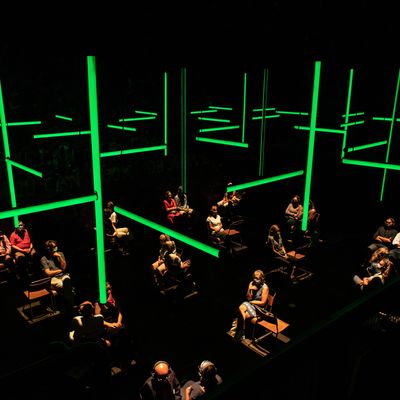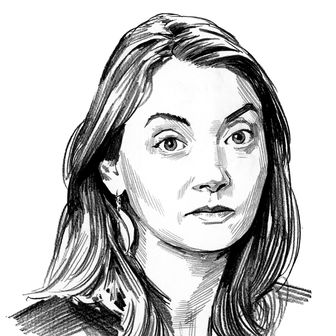
There was a sense of light hysteria in line outside the Daryl Roth Theatre in Union Square, the first conventional theater in New York to open its doors to an audience since the shutdown. It was a sunny afternoon, bright and cold, and our high spirits might have been euphoria or fear. (Even if you were the one feeling the buzz, it was hard to tell.) There was paperwork and contactless ticketing to work out, though, so there was also a sense of busy studiousness. Then, suddenly, there were cameras! And striding beside the line came our sky-high mayor, the six-foot-five Bill de Blasio himself, aides and photographers buzzing around him like prop planes around the Empire State Building. He elbow-bumped with people; he cheered on the theater industry’s return. It was a little show outside a show, a parade of one, for an audience of everybody.
Inside the theater, Blindness had a little trouble living up to the outdoor hype. Was this truly a return? Not if you mean live performance when you say theater. Blindness is an installation, meaning that there is no actor actually present in the room. Instead the audience listens to Juliet Stevenson’s pre-recorded voice on headphones, while sitting in two-person clusters all across the theater’s floor. (Lizzie Clachan did the design.) The production’s main visual components are the lights, bright tubes handsomely designed by Jessica Hung Han Yan, which hang geometrically like a Dan Flavin piece. They’re eventually lowered around us, hovering at eye level in a grid, fencing in each two-person pod. In the past year, we’ve thought about what we consider “theater” as its boundaries and definitions changed, and certainly this sensation of being physically trapped is a crucial part of it. I had forgotten how that penned-in feeling makes time seem thicker than usual. I stared at the glowing hand on my watch; the seconds slowed. The sense Blindness took from me wasn’t sight, but my pandemic belief that time is slippery and liquid and quick.
Simon Stephens’s audio play is an adaptation of the novel by José Saramago, in which a country’s population suddenly succumbs to a plague of sightlessness. Stevenson speaks first as a narrator — she describes patient zero, struck blind in the middle of traffic — and then as a character, a doctor’s wife who is mysteriously immune. The wife wants to stay with her husband, who is being hustled into enforced quarantine, so she pretends to be blind, and she murmurs her observations to us as if to the husband she’s trying to keep safe. The play becomes ever more painful and frenzied, and the room goes dark. Society wastes no time descending into brutality and chaos — the sighted military shoot at the blind, the blind turn on one another. Stevenson, terrified, whispers hotly in our ear. The binaural sound design by brothers Ben and Max Ringham is so perfectly illusionistic that I had to take off my headphones to reassure myself that she was not actually sitting next to me.
Blindness was originally devised for the Donmar Warehouse by director Walter Meierjohann, and it’s difficult to imagine “seeing” it in August, when it ran in London. Saramago’s novel and its other stagings (Joe Tantalo adapted it in 2007, for instance) have often seemed oddly comforting: Nothing lulls an audience like a post-apocalyptic scenario, since it makes our current reality seem tame by comparison. In August, though, the vaccines were still on the far horizon, and hope was hard to come by. It must have been horrifying to hear such a bleak story eight months ago — it wasn’t totally pleasant in April, and I sat in the Daryl Roth, my vaccine appointments booked and dreams of parent-visitation dancing in my head.
I hugely admire producer Daryl Roth and her team for being able to handle so many of us without crowding. I admire Meierjohann and Stephens and the others for taking the limitations of quarantine-era theater and making something so artistically integrated and whole. And I am boggled at the way Stevenson builds an entire world out of her voice. I hope that in the time to come, they release Blindness for home consumption. I think she could terrorize you just as well if you were listening to her on your headphones at your window — looking out at a world on the brink.
But I will not recommend that anyone else go to an indoor space, to sit with dozens of people for 70 minutes (with the slow start, it might have been as much as 85) to hear a recording. The production is beautifully executed but not ravishing — it’s not worth getting sick for, and infection numbers in our city are climbing and climbing. And shouldn’t we listen to the message of the play itself? One of the fools in Blindness is a dawdling hospital administrator who fails to recognize the crisis, who goes easy in a moment when it could have made a difference to be strict. We are still in dystopia. To pluck one example out of the air, we’re living in a city in which a show like this can’t have an actor in it. It certainly added to my unease to realize that the actors weren’t present because their union doesn’t think it would be safe enough for them. There is no union for audiences, I thought, sweating in my two masks, too late to change my mind about seeing the show. It struck me later that the mayor specifically charged with audience protection had elbow-bumped us as we went inside — and then didn’t stay. He had other engagements.
Blindness is at the Daryl Roth Theatre.


